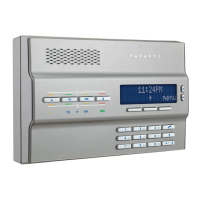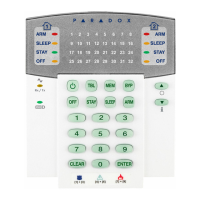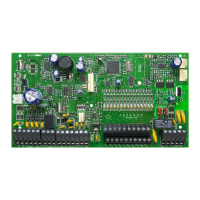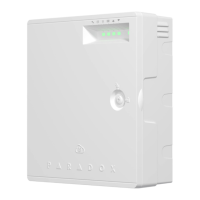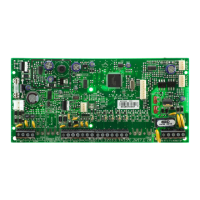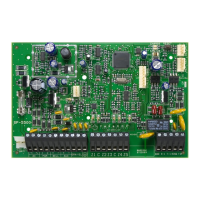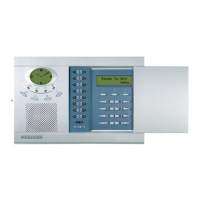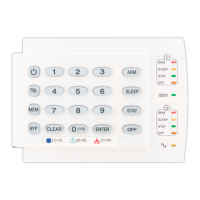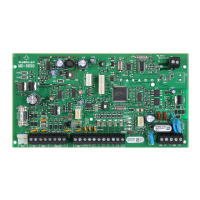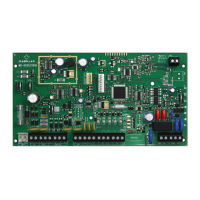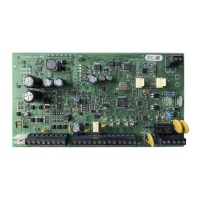Do you have a question about the Paradox Magellan MG-6060 and is the answer not in the manual?
Provides an overview of the Magellan system and manual.
Explains symbols used in the manual for clarity.
Initial steps after powering up the Magellan console.
Steps for setting up user profiles and access codes.
Configuration of communicator settings for reporting.
Procedure to add and configure system zones.
How to perform system tests for hardware and zones.
Setting up various access codes like Installer, Maintenance, Panel ID.
How to set the system's time and date format.
Instructions for connecting AC power to the console.
How to connect and install the backup battery.
Instructions for powering the console via a DC supply.
Connecting the console to a telephone line.
Overview of PGM outputs for activating devices.
Connecting hardwire detection devices to the console.
How to connect the console to WinLoad software.
Connecting the UIP-256 for firmware upgrades.
Connecting an X10 transmitter for home automation.
Connecting a PMC-3 for programming and data transfer.
Criteria for selecting an optimal installation site.
Description of the wall plate and its use.
Step-by-step guide for wall mounting the console.
Instructions for mounting the console on a tabletop.
How to connect the radio antenna for better reception.
Using WinLoad for remote or on-site programming.
Accessing programming mode via the console keypad.
Method for entering decimal or hexadecimal data.
Method for selecting and manipulating options.
Using PMC-3 for identical programming of multiple consoles.
Details on the Installer Code and its function.
Information about the Maintenance Code.
Setting the length of user access codes (4 or 6 digits).
Functionality and limitations of the System Master Code.
How to lock the System Master Code.
Procedure to reset the System Master Code.
Enabling and using a Duress code for silent alerts.
Overview of assigning and defining zone parameters.
Explains the 15 available zone definitions.
Configuration for Entry Delay 1 zones.
Setting the duration for Entry Delay 1.
Configuration for Entry Delay 2 zones.
Setting the duration for Entry Delay 2.
How Follow zones function in different arming states.
Behavior of Follow/Stay zones under different arming modes.
Configuration and use of Instant zones.
Behavior of Instant/Stay zones under different arming modes.
How standard 24-hour fire zones behave.
Configuration and behavior of Delayed Fire Zones.
How 24-hour burglary zones function.
Configuration and reporting for 24-hour hold-up zones.
How 24-hour buzzer zones alert the user.
Functionality of 24-hour gas detection zones.
Configuration for 24-hour heat detection zones.
How 24-hour water leak detection zones operate.
Configuration for 24-hour freeze detection zones.
General zone options like Auto-zone Shutdown, Bypass.
How zones automatically shut down after multiple alarms.
Setting the number of alarms before shutdown.
Enabling or disabling the bypass option for zones.
Defining how the console reacts to different alarm types.
Feature to reduce false alarms using Intellizone.
Setting the delay for Intellizone activation.
Delaying report transmission after an alarm.
Setting the delay for transmitting alarm reports.
How Force zones behave when arming the system.
Configuration for Stay Delay zones.
Converting wireless zones 15/16 to hardwire inputs.
Using EOL resistors for hardwire zones.
Steps to assign wireless transmitters to zones.
How to assign wireless doorbells to the console.
Selecting tones for wireless doorbells.
Procedure to delete assigned wireless transmitters.
Checking the signal strength of wireless transmitters.
Customizing remote control button functions.
Assigning programmable remote controls to user codes.
Configuring regular arming to switch to stay arming.
Configuring regular arming to force arming.
Configuring stay arming to force arming.
Setting the system for automatic daily arming.
Setting the time for automatic arming.
Automatic arming based on lack of movement.
Setting the inactivity period for auto-arming.
Selecting arming method for auto-arming.
Enabling one-touch arming for users.
Setting the time to leave the premises after arming.
Enabling siren squawks for remote arm/disarm.
Disabling exit delay when arming remotely.
Reducing exit delay if a zone is closed during exit.
Switching follow zones to Entry Delay 2.
Timer for verifying last arming time.
Delay for siren activation during stay arm.
Setting the siren cutoff time after an alarm.
How the system reacts to supervision loss.
Enabling supervision for wireless transmitters.
Setting the time window for check-in signals.
How the system reacts to zone tampers.
Handling supervision loss on bypassed zones.
Enabling backup communication supervision.
Configuring and enabling panic alarm functions.
Key combinations for activating panic alarms.
Setting panic alarms as silent, audible, or pulsed.
Delay before remote disarming after a panic alarm.
Overview of report codes for system events.
Report codes for different arming events.
Report codes for special arming features.
Report codes for system disarming events.
Report codes for special disarming events.
Report codes for zone alarms.
Report codes for zone alarm restores.
Report codes for specific alarm conditions.
Report codes for zone tamper events.
Report codes for zone tamper restores.
Report codes for system troubles.
Programming up to two monitoring station numbers.
Setting primary and secondary monitoring numbers.
Configuring MSTN 2 as a backup number.
Programming the pager telephone number.
Programming the numeric message for pagers.
Programming numbers for voice message playback.
Setting repetitions for voice messages.
Programming a number for service calls.
Customizing event reporting via voice messages.
Entering the console's account number.
Setting communication formats for monitoring stations.
Defining call direction for different events.
Selecting between pulse and tone dialing.
Setting the pulse ratio for pulse dialing.
Enabling switch to pulse dialing after multiple failed attempts.
Enabling and configuring telephone line monitoring.
Scheduling automatic test reports.
Options for when disarming events are reported.
Options for reporting zone restorations.
Enabling detection of RF interference.
Programming PGM activation based on system events.
Programming PGM deactivation based on events.
Setting a delay before PGM deactivation.
Setting onboard PGMs to normally open or closed.
Programming wireless PGM activation based on events.
Programming wireless PGM deactivation based on events.
Setting a delay before wireless PGM deactivation.
Resetting all programmed sections to factory defaults.
Locking programming to prevent unauthorized changes.
Monitoring the console's on-board tamper status.
Enabling audible warnings for trouble conditions.
Enabling or disabling the FM tuner when armed.
Automatic adjustment for daylight saving time.
Enabling warnings for AC power failures.
Accessing and understanding the trouble display.
Configuring how Magellan answers computer calls.
Overriding answering machines for WinLoad communication.
Setting the number of rings before answering.
Programming the PC telephone number for WinLoad.
Enabling call back for enhanced security.
Setting the panel identifier for WinLoad.
Setting the PC password for WinLoad communication.
General FCC compliance information.
Requirements for notifying the telephone company.
Standards for connecting equipment to the phone network.
Procedures if equipment causes harm to the network.
How telephone company changes affect equipment.
General rules for telephone equipment use.
Understanding REN for connecting devices.
User information regarding FCC Part 15 compliance.
Provides an overview of the Magellan system and manual.
Explains symbols used in the manual for clarity.
Initial steps after powering up the Magellan console.
Steps for setting up user profiles and access codes.
Configuration of communicator settings for reporting.
Procedure to add and configure system zones.
How to perform system tests for hardware and zones.
Setting up various access codes like Installer, Maintenance, Panel ID.
How to set the system's time and date format.
Instructions for connecting AC power to the console.
How to connect and install the backup battery.
Instructions for powering the console via a DC supply.
Connecting the console to a telephone line.
Overview of PGM outputs for activating devices.
Connecting hardwire detection devices to the console.
How to connect the console to WinLoad software.
Connecting the UIP-256 for firmware upgrades.
Connecting an X10 transmitter for home automation.
Connecting a PMC-3 for programming and data transfer.
Criteria for selecting an optimal installation site.
Description of the wall plate and its use.
Step-by-step guide for wall mounting the console.
Instructions for mounting the console on a tabletop.
How to connect the radio antenna for better reception.
Using WinLoad for remote or on-site programming.
Accessing programming mode via the console keypad.
Method for entering decimal or hexadecimal data.
Method for selecting and manipulating options.
Using PMC-3 for identical programming of multiple consoles.
Details on the Installer Code and its function.
Information about the Maintenance Code.
Setting the length of user access codes (4 or 6 digits).
Functionality and limitations of the System Master Code.
How to lock the System Master Code.
Procedure to reset the System Master Code.
Enabling and using a Duress code for silent alerts.
Overview of assigning and defining zone parameters.
Explains the 15 available zone definitions.
Configuration for Entry Delay 1 zones.
Setting the duration for Entry Delay 1.
Configuration for Entry Delay 2 zones.
Setting the duration for Entry Delay 2.
How Follow zones function in different arming states.
Behavior of Follow/Stay zones under different arming modes.
Configuration and use of Instant zones.
Behavior of Instant/Stay zones under different arming modes.
How standard 24-hour fire zones behave.
Configuration and behavior of Delayed Fire Zones.
How 24-hour burglary zones function.
Configuration and reporting for 24-hour hold-up zones.
How 24-hour buzzer zones alert the user.
Functionality of 24-hour gas detection zones.
Configuration for 24-hour heat detection zones.
How 24-hour water leak detection zones operate.
Configuration for 24-hour freeze detection zones.
General zone options like Auto-zone Shutdown, Bypass.
How zones automatically shut down after multiple alarms.
Setting the number of alarms before shutdown.
Enabling or disabling the bypass option for zones.
Defining how the console reacts to different alarm types.
Feature to reduce false alarms using Intellizone.
Setting the delay for Intellizone activation.
Delaying report transmission after an alarm.
Setting the delay for transmitting alarm reports.
How Force zones behave when arming the system.
Configuration for Stay Delay zones.
Converting wireless zones 15/16 to hardwire inputs.
Using EOL resistors for hardwire zones.
Steps to assign wireless transmitters to zones.
How to assign wireless doorbells to the console.
Selecting tones for wireless doorbells.
Procedure to delete assigned wireless transmitters.
Checking the signal strength of wireless transmitters.
Customizing remote control button functions.
Assigning programmable remote controls to user codes.
Configuring regular arming to switch to stay arming.
Configuring regular arming to force arming.
Configuring stay arming to force arming.
Setting the system for automatic daily arming.
Setting the time for automatic arming.
Automatic arming based on lack of movement.
Setting the inactivity period for auto-arming.
Selecting arming method for auto-arming.
Enabling one-touch arming for users.
Setting the time to leave the premises after arming.
Enabling siren squawks for remote arm/disarm.
Disabling exit delay when arming remotely.
Reducing exit delay if a zone is closed during exit.
Switching follow zones to Entry Delay 2.
Timer for verifying last arming time.
Delay for siren activation during stay arm.
Setting the siren cutoff time after an alarm.
How the system reacts to supervision loss.
Enabling supervision for wireless transmitters.
Setting the time window for check-in signals.
How the system reacts to zone tampers.
Handling supervision loss on bypassed zones.
Enabling backup communication supervision.
Configuring and enabling panic alarm functions.
Key combinations for activating panic alarms.
Setting panic alarms as silent, audible, or pulsed.
Delay before remote disarming after a panic alarm.
Overview of report codes for system events.
Report codes for different arming events.
Report codes for special arming features.
Report codes for system disarming events.
Report codes for special disarming events.
Report codes for zone alarms.
Report codes for zone alarm restores.
Report codes for specific alarm conditions.
Report codes for zone tamper events.
Report codes for zone tamper restores.
Report codes for system troubles.
Programming up to two monitoring station numbers.
Setting primary and secondary monitoring numbers.
Configuring MSTN 2 as a backup number.
Programming the pager telephone number.
Programming the numeric message for pagers.
Programming numbers for voice message playback.
Setting repetitions for voice messages.
Programming a number for service calls.
Customizing event reporting via voice messages.
Entering the console's account number.
Setting communication formats for monitoring stations.
Defining call direction for different events.
Selecting between pulse and tone dialing.
Setting the pulse ratio for pulse dialing.
Enabling switch to pulse dialing after multiple failed attempts.
Enabling and configuring telephone line monitoring.
Scheduling automatic test reports.
Options for when disarming events are reported.
Options for reporting zone restorations.
Enabling detection of RF interference.
Programming PGM activation based on system events.
Programming PGM deactivation based on events.
Setting a delay before PGM deactivation.
Setting onboard PGMs to normally open or closed.
Programming wireless PGM activation based on events.
Programming wireless PGM deactivation based on events.
Setting a delay before wireless PGM deactivation.
Resetting all programmed sections to factory defaults.
Locking programming to prevent unauthorized changes.
Monitoring the console's on-board tamper status.
Enabling audible warnings for trouble conditions.
Enabling or disabling the FM tuner when armed.
Automatic adjustment for daylight saving time.
Enabling warnings for AC power failures.
Accessing and understanding the trouble display.
Configuring how Magellan answers computer calls.
Overriding answering machines for WinLoad communication.
Setting the number of rings before answering.
Programming the PC telephone number for WinLoad.
Enabling call back for enhanced security.
Setting the panel identifier for WinLoad.
Setting the PC password for WinLoad communication.
General FCC compliance information.
Requirements for notifying the telephone company.
Standards for connecting equipment to the phone network.
Procedures if equipment causes harm to the network.
How telephone company changes affect equipment.
General rules for telephone equipment use.
Understanding REN for connecting devices.
User information regarding FCC Part 15 compliance.
| Brand | Paradox |
|---|---|
| Model | Magellan MG-6060 |
| Category | Security System |
| Language | English |
